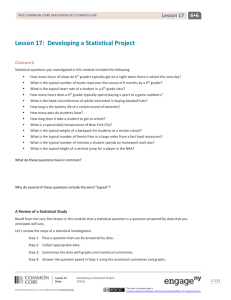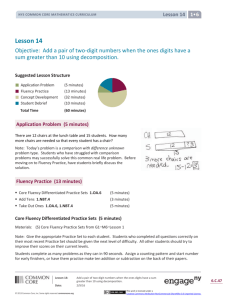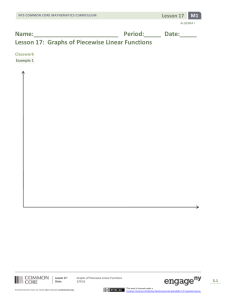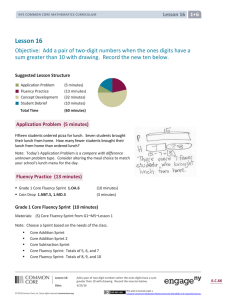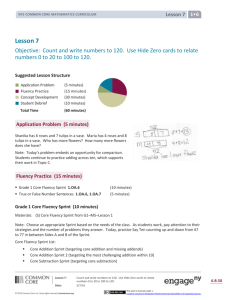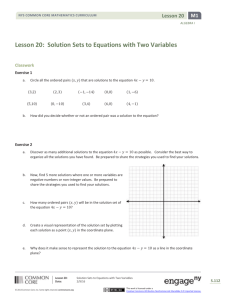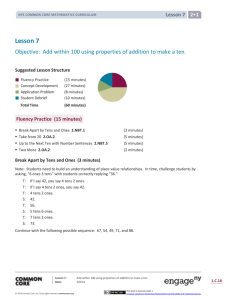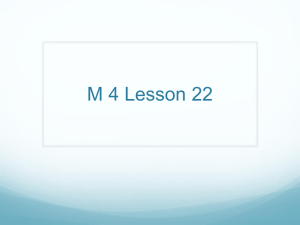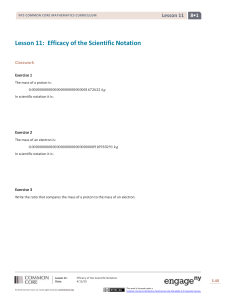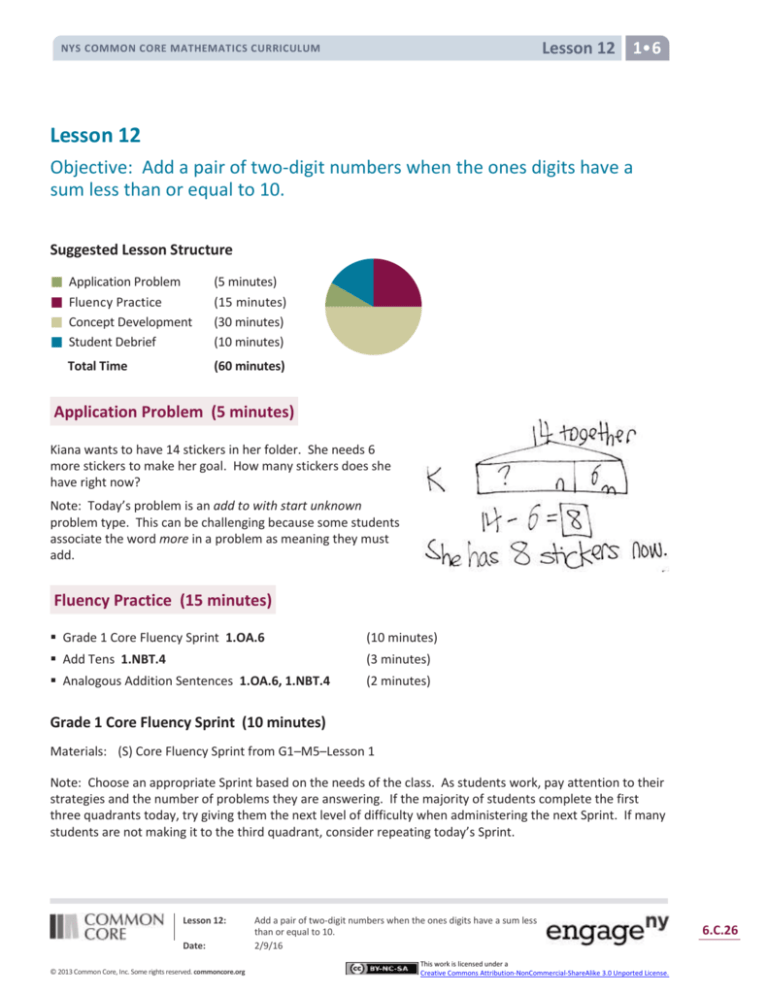
Lesson 12 1•6
NYS COMMON CORE MATHEMATICS CURRICULUM
Lesson 12
Objective: Add a pair of two-digit numbers when the ones digits have a
sum less than or equal to 10.
Suggested Lesson Structure
Application Problem
Fluency Practice
Concept Development
Student Debrief
Total Time
(5 minutes)
(15 minutes)
(30 minutes)
(10 minutes)
(60 minutes)
Application Problem (5 minutes)
Kiana wants to have 14 stickers in her folder. She needs 6
more stickers to make her goal. How many stickers does she
have right now?
Note: Today’s problem is an add to with start unknown
problem type. This can be challenging because some students
associate the word more in a problem as meaning they must
add.
Fluency Practice (15 minutes)
Grade 1 Core Fluency Sprint 1.OA.6
(10 minutes)
Add Tens 1.NBT.4
(3 minutes)
Analogous Addition Sentences 1.OA.6, 1.NBT.4
(2 minutes)
Grade 1 Core Fluency Sprint (10 minutes)
Materials: (S) Core Fluency Sprint from G1–M5–Lesson 1
Note: Choose an appropriate Sprint based on the needs of the class. As students work, pay attention to their
strategies and the number of problems they are answering. If the majority of students complete the first
three quadrants today, try giving them the next level of difficulty when administering the next Sprint. If many
students are not making it to the third quadrant, consider repeating today’s Sprint.
Lesson 12:
Date:
© 2013 Common Core, Inc. Some rights reserved. commoncore.org
Add a pair of two-digit numbers when the ones digits have a sum less
than or equal to 10.
2/9/16
This work is licensed under a
Creative Commons Attribution-NonCommercial-ShareAlike 3.0 Unported License.
6.C.26
Lesson 12 1•6
NYS COMMON CORE MATHEMATICS CURRICULUM
Core Fluency Sprint List:
Core Addition Sprint
Core Addition Sprint 2
Core Subtraction Sprint
Core Fluency Sprint: Totals of 5, 6, and 7
Core Fluency Sprint: Totals of 8, 9, and 10
Add Tens (3 minutes)
Materials: (S) Personal white boards, die per pair of students
Note: This fluency activity reviews adding multiples of 10 to two-digit numbers, which helps prepare students
for today’s lesson.
Choose a student to help model the activity. Then assign partners of equal ability to work together.
Partner A writes or draws a number (with quick tens and ones) between 10 and 40 (e.g., 25).
Partner B rolls the die to determine the number of tens to add (e.g., if she rolls 5, add 5 tens).
Both partners write the number sentence on their personal boards and check each other’s work
(e.g., 25 + 50 = 75).
Analogous Addition Sentences (2 minutes)
Note: This fluency activity encourages students to use sums within 10 to solve more challenging problems.
Reviewing adding a one-digit number to a two-digit number when the ones have a sum less than or equal to
10 prepares students for today’s lesson.
T:
S:
T:
S:
T:
S:
T:
S:
Say the number sentence with the answer. 3 + 2.
3 + 2 = 5.
43 + 2.
43 + 2 = 45.
42 + 3.
42 + 3 = 45.
3 + 42.
3 + 42 = 45.
Continue with the following suggested sequence:
6+2
56 + 2
96 + 2
42 + 6
4+3
64 + 3
63 + 4
4 + 63
Lesson 12:
Date:
© 2013 Common Core, Inc. Some rights reserved. commoncore.org
6+3
96 + 3
93 + 6
6 + 93
Add a pair of two-digit numbers when the ones digits have a sum less
than or equal to 10.
2/9/16
This work is licensed under a
Creative Commons Attribution-NonCommercial-ShareAlike 3.0 Unported License.
6.C.27
Lesson 12 1•6
NYS COMMON CORE MATHEMATICS CURRICULUM
Concept Development (30 minutes)
Materials: (T) Chart paper (S) Personal white boards
NOTES ON
MULTIPLE MEANS OF
ACTION AND
EXPRESSION:
Begin today’s lesson with students sitting at their desks or
tables with their materials.
Three sets of problems have been provided for students to
extend their double-digit addition skills from G1–Module 4.
Choose the appropriate set, or portion of a set, that best meets
students’ needs. Although it may be tempting to begin with a
review of a particular method to solve problems, refrain from
doing so at the onset of the lesson. Instead, encourage and
MP.5
remind students of their tool kit: number sentences, the place
value chart, linking cubes, drawings, number bonds, counting
on, etc. Although students may ask questions, resist giving hints
or solving the problem as a class, but continue to ask questions
that will prompt students to use their tool kit. For example,
“How can this be solved? What method could you use?”
Some students may benefit from more
concrete or pictorial supports. Use
linking cubes in ten-sticks and ones as
well as quick ten drawings for these
students. While supporting students
with these materials, be sure to
connect them with number sentences
with decomposed bonds to support
increased understanding. See
G1−M4−Lesson 24 for examples of how
these materials have been used for
similar instructional objectives.
After each problem, have students share their solutions and
invite one or two students to explain their strategy. Today, try
to pre-select students that have used varied strategies, such as
adding ones first or adding tens first. Encourage students to use
place value language to describe strategies for solving. Ask
questions such as, “What is another way this can be solved?
Why did you choose your method?”
In Problems 1–4 pairs of two-digit numbers from G1–Module 4–
Lessons 24 and 25 are presented with an analogous problem
using numbers from 40 to 100 from G1–Module 6.
Problems 5–8 provide a scaffold-less opportunity to add pairs of two-digit numbers.
Problems 9–12 encourage students to identify the missing number in varied positions within the number
sentence.
Problems 1–4
Problems 5–8
Problems 9–12
24 + 13, then solve 54 + 13
76 + 23
63 + ____ = 84
15 + 13, then solve 45 + 23
23 + 57
48 + ____ = 100
15 + 15, then solve 45 + 45
41 + 39
____ + 59 = 70
26 + 14, then solve 66 + 34
34 + 53
32 + ____ = 100
Should students need additional support, the following dialogue presents a more guided approach to
Problems 1–4.
T:
(Write 24 + 10 on chart paper.) Use quick tens to
Lesson 12:
Date:
© 2013 Common Core, Inc. Some rights reserved. commoncore.org
Add a pair of two-digit numbers when the ones digits have a sum less
than or equal to 10.
2/9/16
This work is licensed under a
Creative Commons Attribution-NonCommercial-ShareAlike 3.0 Unported License.
6.C.28
Lesson 12 1•6
NYS COMMON CORE MATHEMATICS CURRICULUM
T:
S:
T:
T:
S:
T:
S:
T:
T:
T:
T:
S:
show and solve this problem. (Wait as students draw
on their personal boards.)
24 + 10 is…?
34!
(Write 24 + 13 on chart paper.) Use quick tens to
show and solve this problem. (Wait as students draw
on their personal boards.)
24 + 13 is…?
37!
What did you do to solve this problem? Turn and talk
with a partner. (Wait as students discuss.)
I took apart 13, making it 10 and 3. I added 10 first,
that’s 34, and then 3 more makes 37. I already
know 24 + 10 was 34, so 3 more was 37.
(As students explain, use number bonds with number
sentences to record their process.)
Great job adding the tens and then adding the rest of
the ones.
(Write 54 + 13 on chart paper.) Solve this problem
using your same thinking. If quick tens will help you,
use them, or challenge yourself to use number bonds
with your number sentence to solve the problem.
(Wait as students draw on personal boards.)
54 + 13 is…?
67!
NOTES ON
MULTIPLE MEANS OF
ACTION AND
EXPRESSION:
Encourage students to explain their
thinking about adding or subtracting
tens. Students may learn as much
from each other’s reasoning as from
the lesson. This also provides the
opportunity for the teacher to learn
more about a student’s level of
thinking and ability to express that
thinking.
Invite students to share how they solved this problem. Emphasize their process of decomposing at least one
number into tens and ones as they put the addends together. Repeat this process for 15 + 13 and 45 + 13.
When beginning 15 + 15, note that students may choose to add the ones first as shown demonstrated below.
T:
T:
S:
T:
S:
(Write 15 + 15 on chart paper.) Solve this problem. (Wait as students solve.)
15 + 15 is…?
30!
What did you do to solve this problem?
I took apart the second 15, making it 10 and 5. I added 10
first; that’s 25, and then 5 more makes it 30. I started the
same way, but I added 15 + 5 first; that’s 20, and then added
10 more to make 30. I made both fifteens into 10 and 5. I
added 5 and 5 to make 10, so then I had 3 tens. That’s 30.
Use number bonds and number sentences to record students’ methods.
If all students add the tens first, pose the other methods as ways that you
solved the problem, as an opportunity to consider alternative methods.
Lesson 12:
Date:
© 2013 Common Core, Inc. Some rights reserved. commoncore.org
Add a pair of two-digit numbers when the ones digits have a sum less
than or equal to 10.
2/9/16
This work is licensed under a
Creative Commons Attribution-NonCommercial-ShareAlike 3.0 Unported License.
6.C.29
Lesson 12 1•6
NYS COMMON CORE MATHEMATICS CURRICULUM
T:
S:
(Point to the example while describing each
method.) Some of you broke the second 15 into
tens and ones and added the tens first and then
the ones. Some of you broke the second 15 into
tens and ones and added the ones first and then
the tens. A few of you broke both fifteens into
tens and ones and added ones with ones and
tens with tens. Did you all find the total of 30?
Yes!
Have students work on the following problems or repeat
the same process with the following 45 + 45, 26 + 14, and
66 + 34.
Problem Set (10 minutes)
Students should do their personal best to complete the
Problem Set within the allotted 10 minutes. For some
classes, it may be appropriate to modify the assignment by
specifying which problems they work on first. Some
problems do not specify a method for solving. Students
solve these problems using the RDW approach used for
Application Problems.
Student Debrief (10 minutes)
Lesson Objective: Add a pair of two-digit numbers
when the ones digits have a sum less than or equal to
10.
The Student Debrief is intended to invite reflection and
active processing of the total lesson experience.
Invite students to review their solutions for the Problem
Set. They should check work by comparing answers
with a partner before going over answers as a class.
Look for misconceptions or misunderstandings that can
be addressed in the Debrief. Guide students in a
conversation to debrief the Problem Set and process
the lesson.
You may choose to use any combination of the questions
below to lead the discussion.
Look at Problem 1. Did you solve all of your
problems the same way? What was your strategy?
Did anyone solve some problems one way, and then use a different strategy to solve other
Lesson 12:
Date:
© 2013 Common Core, Inc. Some rights reserved. commoncore.org
Add a pair of two-digit numbers when the ones digits have a sum less
than or equal to 10.
2/9/16
This work is licensed under a
Creative Commons Attribution-NonCommercial-ShareAlike 3.0 Unported License.
6.C.30
Lesson 12 1•6
NYS COMMON CORE MATHEMATICS CURRICULUM
problems? Explain your reasoning.
How does yesterday’s work with adding multiples of 10 connect to today’s work?
How did your fluency work today help you with
today’s problems? Use specific examples to
explain your thinking.
Look at your Application Problem. Share your solution and your strategy for solving.
Exit Ticket (3 minutes)
After the Student Debrief, instruct students to complete the Exit Ticket. A review of their work will help you
assess the students’ understanding of the concepts that were presented in the lesson today and plan more
effectively for future lessons. You may read the questions aloud to the students.
Lesson 12:
Date:
© 2013 Common Core, Inc. Some rights reserved. commoncore.org
Add a pair of two-digit numbers when the ones digits have a sum less
than or equal to 10.
2/9/16
This work is licensed under a
Creative Commons Attribution-NonCommercial-ShareAlike 3.0 Unported License.
6.C.31
NYS COMMON CORE MATHEMATICS CURRICULUM
Name
Lesson 12 Problem Set 1•6
Date
1. Solve.
a. 84 + 12 = _____
b. 71 + 26 = _____
c. 57 + 22 = _____
d. 59 + 41 = _____
e. 35 + 65 = _____
f. 26 + 54 = _____
g. 57 + 42 = _____
h. 37 + 63 = _____
Lesson 12:
Date:
© 2013 Common Core, Inc. Some rights reserved. commoncore.org
Add a pair of two-digit numbers when the ones digits have a sum less
than or equal to 10.
2/9/16
This work is licensed under a
Creative Commons Attribution-NonCommercial-ShareAlike 3.0 Unported License.
6.C.32
NYS COMMON CORE MATHEMATICS CURRICULUM
Lesson 12 Problem Set 1•6
2. Solve.
a. 45 + 13 = _____
b. 45 + 23 = _____
c. 21 + 27 = _____
d. 27 + 23 = _____
e. 48 + 32 = _____
f. 48 + 52 = _____
g. 34 + 65 = _____
h. 46 + 43 = _____
Lesson 12:
Date:
© 2013 Common Core, Inc. Some rights reserved. commoncore.org
Add a pair of two-digit numbers when the ones digits have a sum less
than or equal to 10.
2/9/16
This work is licensed under a
Creative Commons Attribution-NonCommercial-ShareAlike 3.0 Unported License.
6.C.33
NYS COMMON CORE MATHEMATICS CURRICULUM
Name
Lesson 12 Exit Ticket 1•6
Date
1. Solve using number bonds. You may choose to add the ones or tens first. Write the
two number sentences to show what you did.
a. 56 + 43 = _____
Lesson 12:
Date:
© 2013 Common Core, Inc. Some rights reserved. commoncore.org
b. 22 + 75 = _____
Add a pair of two-digit numbers when the ones digits have a sum less
than or equal to 10.
2/9/16
This work is licensed under a
Creative Commons Attribution-NonCommercial-ShareAlike 3.0 Unported License.
6.C.34
NYS COMMON CORE MATHEMATICS CURRICULUM
Name
Lesson 12 Homework 1•6
Date
1. Solve.
a. 46 + 22 = _____
b. 74+ 23 = _____
c. 54 + 25 = _____
d. 68 + 31 = _____
e. 45 + 55 = _____
f. 86 + 13 = _____
g. 37 + 52 = _____
h. 47 + 52 = _____
Lesson 12:
Date:
© 2013 Common Core, Inc. Some rights reserved. commoncore.org
Add a pair of two-digit numbers when the ones digits have a sum less
than or equal to 10.
2/9/16
This work is licensed under a
Creative Commons Attribution-NonCommercial-ShareAlike 3.0 Unported License.
6.C.35
NYS COMMON CORE MATHEMATICS CURRICULUM
Lesson 12 Homework 1•6
2. Solve using number bonds. You may choose to add the ones or tens first. Write the
two number sentences to show what you did.
a. 76 + 23 = _____
b. 45 + 33 = _____
c. 31 + 67 = _____
d. 57 + 32 = _____
e. 58 + 21 = _____
f. 25 + 63 = _____
g. 44 + 55 = _____
h. 47 + 53 = _____
Lesson 12:
Date:
© 2013 Common Core, Inc. Some rights reserved. commoncore.org
Add a pair of two-digit numbers when the ones digits have a sum less
than or equal to 10.
2/9/16
This work is licensed under a
Creative Commons Attribution-NonCommercial-ShareAlike 3.0 Unported License.
6.C.36


